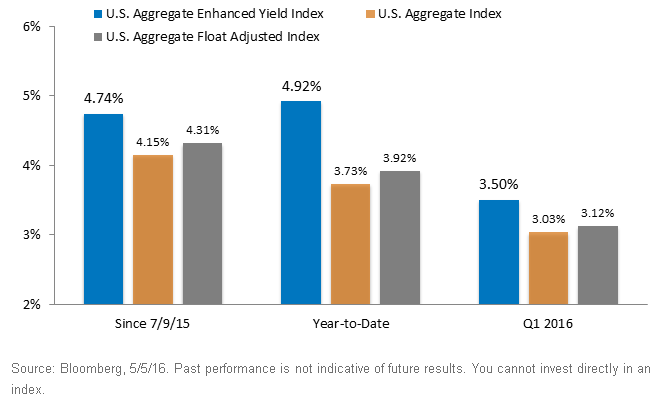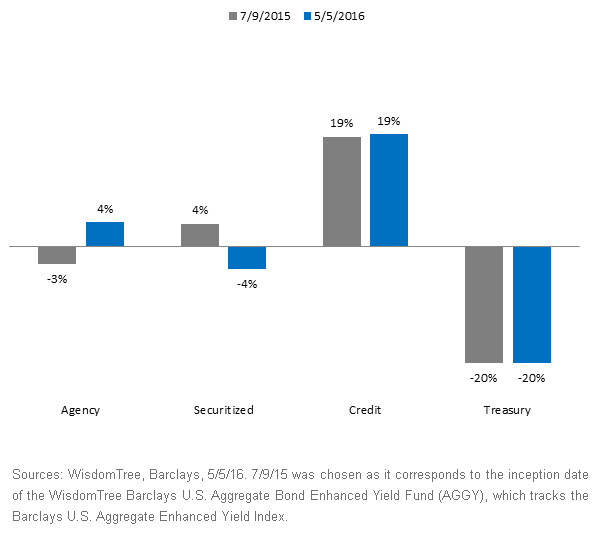
Senior Solutions Specialist – ETF Model Portfolios
2016 has been a
volatile year for many asset classes. During times like these, it is not unusual for
safe-haven assets, such as U.S.
investment-grade fixed income, to experience outsized total returns. However, this rally is not just about a
risk-off scenario leading to a run-up in bond prices. In fact, since the February 11 lows of stocks and crude oil, there has been a powerful rally in almost every asset group.
Corporate bonds have benefited more than
government bonds from this rally as their return comes not only from broad
interest rate movements, but also from an element of
credit risk. By investing in portfolios over-weight to government securities, investors could be missing out on rallies from credit-sensitive bonds, which tend to outperform in times of strong equity movement, while also providing a potential for higher level of income.
While the vast majority of fixed income assets are managed by
active managers, several
market cap-weighted strategies have amassed a lot of assets over the past few decades. These strategies track indexes such as the
Barclays U.S. Aggregate (Agg), which represents the broad universe of U.S.-dollar-denominated investment-grade bonds, inclusive of government, securitized and corporate bonds. While corporations have issued a lot of debt over the past few years, they have been far outpaced by the U.S. government in the amount of issuance. For this reason, investing in strategies tracking market cap-weighted indexes such as the Agg, to which more than $65 billion is managed in exchange-traded funds (ETFs) alone, leaves investors with a large portion of their bond positions in government debt, without a conscious or fundamental reason to do so. In fact, the Agg has 22% concentrated in
Treasury securities
maturing in less than five years.
Agg Enhanced Is Outperforming the Two Most Popular Market Cap-Weighted Core Strategies
On the other hand, there are strategies out there that deviate from this approach to weight by factors that matter to investors. The
Barclays U.S. Aggregate Enhanced Yield Index (Agg Enhanced) draws from the same securities as the Agg, but gives a higher weight to those buckets that have a higher
yield. Its methodology also has certain constraints that provide guardrails against deviating from the Agg’s exposures too much. For example, the total duration of the Agg Enhanced cannot be more than one year from the
duration of the Agg. In addition, major sector weights cannot deviate more than 20% from those of the Agg.
Given that corporates typically out-yield
Treasuries, it is no shock that they are given a higher weight in Agg Enhanced as well. The monthly
rebalance process toward higher-yielding securities has not only enhanced its yield versus the Agg, but has also led to outperformance. As shown below, the Agg Enhanced has outperformed the Agg by 1.19% year-to-date, and by about 0.43% since the middle of last year. Even the
Barclays US Aggregate Float Adjusted Index, which excludes bonds held by governments, company insiders and affiliates, trails by 100
basis points (bps) year-to-date and by 43 bps from the second half of 2015 onward. Both of these Indexes are tracked by several billion in assets by ETFs and mutual funds.
Total Returns as of 5/5/16
 7/9/15 chosen as a start date as it corresponds to the inception date of the WisdomTree Barclays U.S. Aggregate Bond Enhanced Yield Fund (AGGY), which tracks the Barclays U.S. Aggregate Enhanced Yield Index.
7/9/15 chosen as a start date as it corresponds to the inception date of the WisdomTree Barclays U.S. Aggregate Bond Enhanced Yield Fund (AGGY), which tracks the Barclays U.S. Aggregate Enhanced Yield Index.
A look at the underlying exposures gives insight into both the process and the cause of this outperformance. Below, we see that Agg Enhanced has been over-weight credit and under-weight Treasuries. It is important to note that credit has not outperformed Treasuries on a total return basis during the entire period. In fact, during the second half of 2015, Treasuries marginally outperformed credit. However, the consistent over-weight to credit during this period, as well as the monthly rebalance process, has constantly shifted weights toward higher-yielding credit sectors and away from lower-yielding government sectors. This process effectively “buys low and sells high,” as higher yield implies lower prices. The magnitude of the over-weight stayed relatively consistent over the past few quarters.
Agg Enhanced vs. Agg
Major Sector Over-weights/Under-weights

We believe that credit could continue to outperform Treasuries in the coming months as the U.S. economy keeps progressing amid a low-yield environment. In environments where you can expect balanced fixed income returns, portfolios over-weight to investment-grade credit could perform well. And in the coming year, one marked by the actions of a “
low and slow Fed”, range-bound rates and a growing but not soaring economy, strategies tied to the Barclays U.S. Aggregate Enhanced Yield Index could be well positioned to take advantage of these trends.
Important Risks Related to this Article
There are risks associated with investing, including possible loss of principal. Fixed income investments are subject to interest rate risk; their value will normally decline as interest rates rise. Fixed income investments are also subject to credit risk, the risk that the issuer of a bond will fail to pay interest and principal in a timely manner, or that negative perceptions of the issuer’s ability to make such payments will cause the price of that bond to decline. Investing in mortgage- and asset-backed securities involves interest rate, credit, valuation, extension and liquidity risks and the risk that payments on the underlying assets are delayed, prepaid, subordinated or defaulted on. Due to the investment strategy of the Fund, it may make higher capital gain distributions than other ETFs. Please read the Fund’s prospectus for specific details regarding the Fund’s risk profile.


 7/9/15 chosen as a start date as it corresponds to the inception date of the WisdomTree Barclays U.S. Aggregate Bond Enhanced Yield Fund (AGGY), which tracks the Barclays U.S. Aggregate Enhanced Yield Index.
A look at the underlying exposures gives insight into both the process and the cause of this outperformance. Below, we see that Agg Enhanced has been over-weight credit and under-weight Treasuries. It is important to note that credit has not outperformed Treasuries on a total return basis during the entire period. In fact, during the second half of 2015, Treasuries marginally outperformed credit. However, the consistent over-weight to credit during this period, as well as the monthly rebalance process, has constantly shifted weights toward higher-yielding credit sectors and away from lower-yielding government sectors. This process effectively “buys low and sells high,” as higher yield implies lower prices. The magnitude of the over-weight stayed relatively consistent over the past few quarters.
Agg Enhanced vs. Agg
Major Sector Over-weights/Under-weights
7/9/15 chosen as a start date as it corresponds to the inception date of the WisdomTree Barclays U.S. Aggregate Bond Enhanced Yield Fund (AGGY), which tracks the Barclays U.S. Aggregate Enhanced Yield Index.
A look at the underlying exposures gives insight into both the process and the cause of this outperformance. Below, we see that Agg Enhanced has been over-weight credit and under-weight Treasuries. It is important to note that credit has not outperformed Treasuries on a total return basis during the entire period. In fact, during the second half of 2015, Treasuries marginally outperformed credit. However, the consistent over-weight to credit during this period, as well as the monthly rebalance process, has constantly shifted weights toward higher-yielding credit sectors and away from lower-yielding government sectors. This process effectively “buys low and sells high,” as higher yield implies lower prices. The magnitude of the over-weight stayed relatively consistent over the past few quarters.
Agg Enhanced vs. Agg
Major Sector Over-weights/Under-weights
 We believe that credit could continue to outperform Treasuries in the coming months as the U.S. economy keeps progressing amid a low-yield environment. In environments where you can expect balanced fixed income returns, portfolios over-weight to investment-grade credit could perform well. And in the coming year, one marked by the actions of a “low and slow Fed”, range-bound rates and a growing but not soaring economy, strategies tied to the Barclays U.S. Aggregate Enhanced Yield Index could be well positioned to take advantage of these trends.
We believe that credit could continue to outperform Treasuries in the coming months as the U.S. economy keeps progressing amid a low-yield environment. In environments where you can expect balanced fixed income returns, portfolios over-weight to investment-grade credit could perform well. And in the coming year, one marked by the actions of a “low and slow Fed”, range-bound rates and a growing but not soaring economy, strategies tied to the Barclays U.S. Aggregate Enhanced Yield Index could be well positioned to take advantage of these trends.


